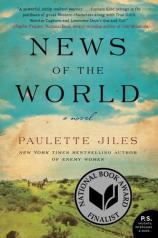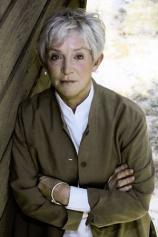Author Talk: October 13, 2016
Paulette Jiles has written across many genres --- including fiction, memoir and poetry --- but clear across all her work is a deep love of the landscape of the Southwest. In her latest book, NEWS OF THE WORLD, she demonstrates that fondness and more in an exquisitely rendered tale about a Civil War captain who must choose between respectability and compassion --- with the life of a young girl hanging in the balance. In this interview, Jiles discusses the real-life inspiration for her protagonist, Captain Kidd, her manifest love of the outdoors, and how good research can be like an addiction.
Question: What draws you to write about the Civil War era?
Paulette Jiles: I was first drawn to it when I was researching the Civil War era in the Missouri Ozarks while doing family genealogy. That research went into ENEMY WOMEN. If you are a writer, research is really kind of an investment, a storehouse of stuff, facts, images and documents ready to hand. I was thinking of a sequel to ENEMY WOMEN in which I envisioned Adair and the Major moving to north Texas. So I looked into conditions in North Texas at the end of the War and discovered stories about the black frontiersman Britt Johnson, which led to more research for THE COLOR OF LIGHTNING. This included discovering Captain Kidd by hearing about him from a neighbor here where I live. This neighbor's ancestor was a real newsreader named Captain Kidd, or Kydd. It also led to looking into the intriguing subject of captives held by the Kiowa and Comanche tribes. And these things gave rise to NEWS OF THE WORLD. When you begin research, you step onto the Yellow Brick Road, and there is no end to it. No end to the stories.
Q: How many months or years of research went into gathering the fascinating historical details we see in the book?
PJ: It is hard to say how much time went into research for NEWS OF THE WORLD, because it all came from that storehouse I have of sources for both the Civil War, Texas and the clothing, etc. of that time. It was cumulative, from two previous novels. I used Wikipedia a great deal and especially the further references at the end of every Wikipedia article, and their sources. Also, I must say the fact-checkers at HarperCollins were wonderful, very keen and interested; they found mistakes I had let slip by, and also pointed me to other sources. To get things right, you have to love research. It's an addiction.
Q: Fans of THE COLOR OF LIGHTNING will be happy to see Britt Johnson reappear in NEWS OF THE WORLD. How did you come upon the idea of bringing him into this narrative?
PJ: I was amazed that he had not been given a fuller treatment in literature. He is an archetypal hero figure, like Roland or Beowulf or El Cid. His story, while true, has all the attributes of the classic tragic hero. I just went back to the scene in THE COLOR OF LIGHTNING when Captain Kidd is reading from a newspaper about the 15th Amendment, while Britt and his crew, Dennis and Paint, stand in the back of the hall listening. It is raining. Something momentous is taking place. I shifted this scene into its own book, page one, and suddenly the subject becomes a captive girl. You can always use a good scene twice!
Q: How would you explain your love of the Texas landscape, which figures so prominently in your overall body of work?
PJ: Some people are just born with a love of landscape or the outdoors, or gardening, or raising large animals, or searching through the non-urban world for treasure. It's in your DNA or something. I am one of those people. We should have a secret sign. Part of the fun of researching THE COLOR OF LIGHTNING was driving up to North Texas with a friend, June Chism, to the Red River country. She and her husband Wayne have relatives there, as well as friends (ranchers) who took me down to the Red River, where I found the place Britt would likely have crossed, and we found the Stone Houses, and visited Spanish Fort, etc. It is a beautiful and also dangerous country. It is dramatic. There are fires, droughts and floods, rolling red land, astonishing skies. June's husband, Wayne Chism, is the one whose ancestor was the real newsreader, who traveled from town to town in North Texas to read the news of the day to those assembled. Captain Kidd or Kydd. The moment Wayne told me about his great-great grandfather, I knew this was a truly great character. I put him into the rainy chill landscape of North Texas in THE COLOR OF LIGHTNING, but I knew there was more there.
Q: What emotional aspect of the story do you think readers will appreciate most?
PJ: I think readers will most appreciate the Captain's courage in doing the right thing. His protection of the innocent, his staunch defense, even to the risk of his life, of a child in need.




